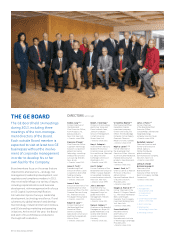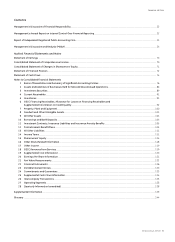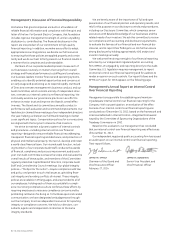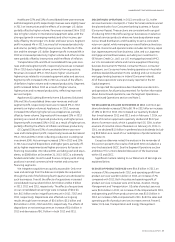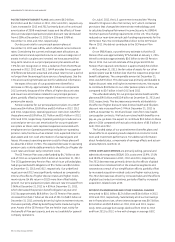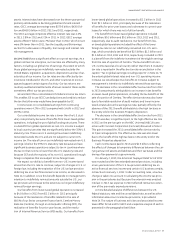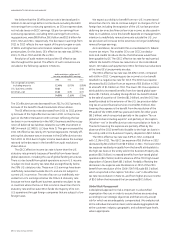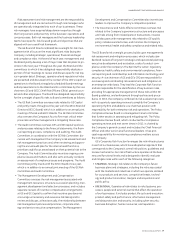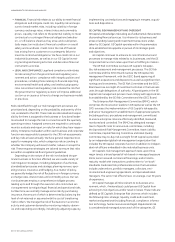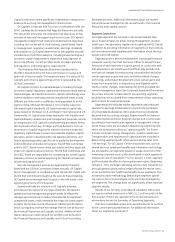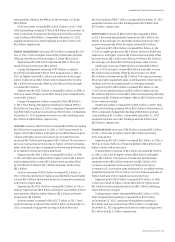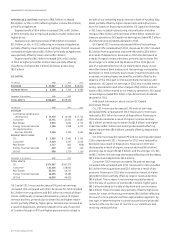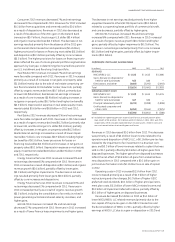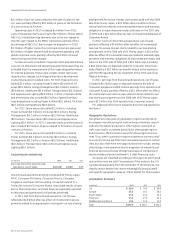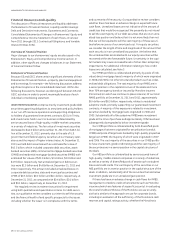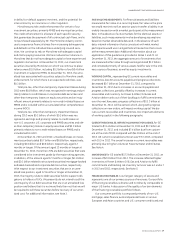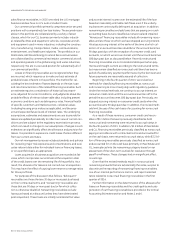GE 2013 Annual Report Download - page 42
Download and view the complete annual report
Please find page 42 of the 2013 GE annual report below. You can navigate through the pages in the report by either clicking on the pages listed below, or by using the keyword search tool below to find specific information within the annual report.’
40 GE 2013 ANNUAL REPORT
• FINANCIAL. Financial risk relates to our ability to meet fi nancial
obligations and mitigate credit risk, liquidity risk and expo-
sure to broad market risks, including volatility in foreign
currency exchange rates, interest rates and commodity
prices. Liquidity risk refers to the potential inability to meet
contractual or contingent fi nancial obligations (whether
on- or off-balance sheet) as they arise, and could poten-
tially impact an institution’s fi nancial condition or overall
safety and soundness. Credit risk is the risk of fi nancial
loss arising from a customer or counterparty failure to
meet its contractual obligations. We face credit risk in our
industrial businesses, as well as in our GE Capital invest-
ing, lending and leasing activities and derivative fi nancial
instruments activities.
•
LEGAL AND COMPLIANCE. Legal and compliance risk relates
to risks arising from the government and regulatory envi-
ronment and action, compliance with integrity policies and
procedures, including those relating to fi nancial reporting,
environmental health and safety, and intellectual property
risks. Government and regulatory risk includes the risk that
the government or regulatory actions will impose additional
cost on us or cause us to have to change our business models
or practices.
Risks identifi ed through our risk management processes are
prioritized and, depending on the probability and severity of the
risk, escalated to the CRO. These risks are discussed and respon-
sibility for them is assigned to the business or functional leader
most suited to manage the risk in connection with the quarterly
operating reviews. Assigned owners are required to continually
monitor, evaluate and report on risks for which they bear respon-
sibility. Enterprise risk leaders within each business and corporate
function are responsible to present to the CRO risk assessments
and key risks at least annually. We have general response strat-
egies for managing risks, which categorize risks according to
whether the Company will avoid, transfer, reduce or accept the
risk. These response strategies are tailored to ensure that risks
are within acceptable GE Board general guidelines.
Depending on the nature of the risk involved and the par-
ticular business or function affected, we use a wide variety of
risk mitigation strategies, including delegation of authorities,
standardized processes and strategic planning reviews, oper-
ating reviews, insurance, and hedging. As a matter of policy,
we generally hedge the risk of fl uctuations in foreign currency
exchange rates, interest rates and commodity prices. Our ser-
vice businesses employ a comprehensive tollgate process
leading up to and through the execution of a contractual ser-
vice agreement to mitigate legal, fi nancial and operational risks.
Furthermore, we centrally manage some risks by purchasing
insurance, the amount of which is determined by balancing the
level of risk retained or assumed with the cost of transferring
risk to others. We manage the risk of fl uctuations in economic
activity and customer demand by monitoring industry dynam-
ics and responding accordingly, including by adjusting capacity,
implementing cost reductions and engaging in mergers, acquisi-
tions and dispositions.
GE CAPITAL RISK MANAGEMENT AND OVERSIGHT
GE Capital acknowledges risk-taking as a fundamental characteristic
of providing fi nancial services. It is inherent to its business and
arises in lending, leasing and investment transactions under-
taken by GE Capital. GE Capital operates within the parameters
of its established risk appetite in pursuit of its strategic goals
and objectives.
GE Capital continues to enhance its risk infrastructure and
processes to manage risks related to its businesses, and the GE
Corporate Risk Function relies upon them in fulfi lling its mission.
The GE Risk Committee oversees GE Capital’s risk appe-
tite, risk assessment and management processes. The GE Risk
Committee and the GECC Board oversee the GE Capital risk
management framework, with the GECC Board approving all
signifi cant acquisitions and dispositions as well as signifi cant bor-
rowings and investments. The GE Risk Committee and the GECC
Board exercise oversight of investment activities in the business
units through delegations of authority. All participants in the GE
Capital risk management process must comply with approval lim-
its established by the GE Risk Committee and the GECC Board.
The Enterprise Risk Management Committee (ERMC), which
comprises the most senior leaders in GE Capital as well as the GE
CRO, oversees the implementation of GE Capital’s risk appetite,
and senior management’s establishment of appropriate systems
(including policies, procedures and management committees)
to ensure enterprise risks are effectively identifi ed, measured,
monitored and controlled. The ERMC has delegated manage-
ment of specifi c risks to various sub-committees, including
the Operational Risk Management Committee, Asset-Liability
Committee, Capital Planning Committee and Asset Quality
Committee. Day-to-day risk oversight for GE Capital is provided
by an independent global risk management organization that
includes the GE Capital corporate function in addition to indepen-
dent risk offi cers embedded in the individual business units.
GE Capital’s risk management approach rests upon three
major tenets: a broad spread of risk based on managed exposure
limits; senior secured commercial fi nancings; and a hold-to-
maturity model with transactions underwritten to “on-book”
standards. Dedicated risk professionals across the businesses
include underwriters, portfolio managers, collectors, envi-
ronmental and engineering specialists, and specialized asset
managers. The senior risk offi cers have, on average, over 30 years
of experience.
GE Capital manages all risks relevant to its business envi-
ronment, which, if materialized, could prevent GE Capital from
achieving its risk objectives and/or result in losses. These risks are
defi ned as GE Capital’s Enterprise Risk Universe, which includes
the following risks: strategic, liquidity, credit and investment,
market and operational (including fi nancial, compliance, informa-
tion technology, human resources and legal). Reputational risk
is considered and managed across each of the categories. GE


